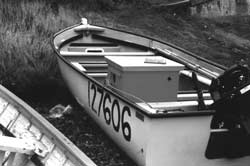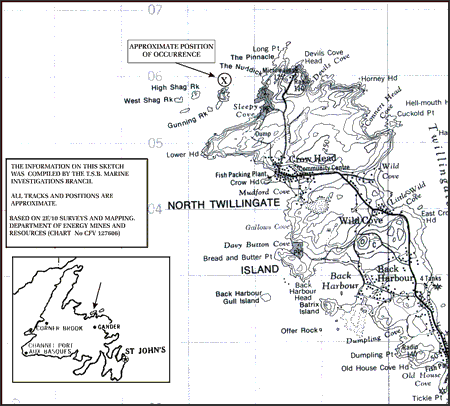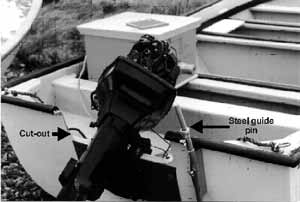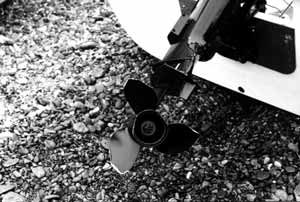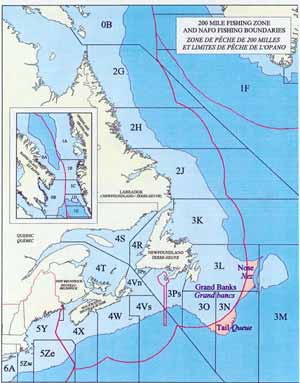Capsizing
Open Boat CFV 127606
Sleepy Cove
North Twillingate, Newfoundland and Labrador
The Transportation Safety Board of Canada (TSB) investigated this occurrence for the purpose of advancing transportation safety. It is not the function of the Board to assign fault or determine civil or criminal liability. This report is not created for use in the context of legal, disciplinary or other proceedings. See Ownership and use of content. Masculine pronouns and position titles may be used to signify all genders to comply with the Canadian Transportation Accident Investigation and Safety Board Act (S.C. 1989, c. 3).
Summary
On 08 October 2000 during daylight hours, while retrieving gill nets during increasing wind and wave conditions, the open boat CFV 127606, with the operator and his crew member on board, capsized close to shore near Sleepy Cove, North Twillingate, Newfoundland and Labrador. One fisher was secured to the overturned boat but did not survive and the other was lost and presumed drowned. Neither of the two men on board was wearing a lifejacket or personal flotation device.
Factual information
Particulars of the vessel
| Name | CFV Number "127606" |
|---|---|
| Home Port | Twillingate Harbour |
| Flag | Canada |
| Type | Fibreglass open fishing boat |
| Gross TonsFootnote 1 | +/- 1 |
| Length O.A. | 5.18 m |
| Breadth | 1.8 m |
| Propulsion | 55 horsepower, single outboard gasoline engine |
| Crew Members | 2 |
| Owner | Private Owner, Durrel, Newfoundland and Labrador |
The Canadian Fishing Vessel (CFV) 127606 is a small open fibreglass fishing boat built from the same mould as many others that operate in the inshore fishery around the coast of Newfoundland. The internal hull is subdivided by transverse thwarts that provide hull strength and form compartments that serve to contain fish, nets and gear. A motor well is provided at the stern.
Built-in buoyancy ensures that the boat remains afloat when swamped or capsized.
The outboard motor is mounted in way of a cut-out at the centre of the stern transom. The lower edge of the cut-out is below the projected line of the gunwale rail and, being the lowest point of freeboard, is an area of the hull most prone to shipping water during fishing operations. A net/line hauler is housed in a weathertight enclosure located at the port side of the compartment just forward of the operator well (Appendix A, Photo 2).
History of the voyage
On Sunday 08 October 2000, at approximately 1045,Footnote 2 the operator and his crew member in the open boat CFV 127606 left their Twillingate wharf heading for the fishing grounds off the northwest coast of North Twillingate Island. The decision to go out had been made quite suddenly.
Both fishers were licenced to fish cod using six gill nets. Their combined total of 12 nets had been used when fishing earlier in the week. Seven of these nets had been taken in on the previous Friday. It was intended to have the remaining five removed the next day to comply with a condition of the licence that required that "all gill nets be removed from the water between 6 PM Saturday and 6 AM Monday." However, the weather on Saturday was bad and no local fishing boats ventured out. That same evening, the operator gave no indication to his family or crew member that he intended to take in the nets the following day, as it was his usual practice not to fish on Sundays.
Four of the nets were located about one-half mile out from the shoreline between Sleepy Cove and Long Point. The other string was said to have been set a little farther out, in deeper water, in a trial attempt to improve upon recent small catches. Under normal circumstances, retrieval of all five nets would have taken about two hours.
When bringing in their gill nets, it was usual to start retrieval from the deeper water placements and work towards the shore. Upon gathering a net marker with the anchoring weight, the net was hauled over a guide placed at the bow. Each section of net brought on board was systematically cleared of seaweed, other bottom debris, and usable fish, and the emptied gear was then conveniently stowed. Winds intensified throughout the morning with waves reaching one to two metres in height, making retrieval of the gill nets more difficult.
At 1449, the Maritime Rescue Sub-Centre (MRSC) in St. John's, Newfoundland and Labrador, was alerted by a local member of the Canadian Coast Guard Auxiliary (CCGA) that an overturned boat had been sighted at approximately 1430 near Long Point at Sleepy Cove Gull Island. Several CCGA vessels (local fishing boats) ventured out in response to the rescue call. The CCGS Cape Roger and a search and rescue (SAR) helicopter were tasked but their arrival on the scene was estimated to take two to three hours. The Royal Canadian Mounted Police (RCMP) advised the MRSC that a small fishing boat was overdue and that the two persons on board had been identified.
The fishers had no means of telecommunication to call for assistance and no other boats had been out fishing in the area that morning. Consequently, no immediate help was at hand at the actual time of the capsizing.
Between 1545 and 1600, a local rescue fishing boat came alongside the capsized vessel that was positioned at approximately 49°41´0.23 N and 54°48´0.92 W. The body of the operator was found secured to the upturned boat and with a net line of floats around his neck. He was not wearing a lifejacket or personal flotation device.
Part of a gill net was found in a bundle near the capsized boat; the other portion was still set. There was no sign of the second fisher at the scene. The CFV 127606 was eventually righted and towed to Crow Head, Newfoundland and Labrador.
An intensive search for the missing crew member was carried out for many days but was hampered by severe weather conditions. He was not found.
Injuries to persons
An autopsy revealed that the operator accidentally died as a result of acute asphyxia due to strangulation. The crew member was later declared lost at sea and presumed drowned.
Condition of the Vessel
The underside of the skeg at the stern showed recent signs of abrasion and the outboard motor cover had been lost. The propeller blades had suffered severe damage and a steel guide pin, securely mounted on the transom, had been bent over by some strong external force. The oars were in the stowed position (Photo 1).
Weather
The marine forecast for Newfoundland and Labrador issued by Environment Canada at 2000 on Saturday 07 October 2000 for the northeast coast Cape St. John's and south was as follows: "Gale warning continued. Winds easterly 10 to 15 knots backing to northeast 15 to 20 Sunday afternoon then increasing to northwest winds 25 to gales 35 Sunday evening. Occasional rain ending Sunday evening. Fog banks. Visibility fair in rain and poor in fog. Little temperature change. Outlook for Monday . . . moderate to strong westerlies diminishing to light winds." The marine forecast at 0300 on Sunday 08 October 2000 was the same.
Seas were moderately heavy with wave heights of one to two metres increasing to two to three metres later in the day. Water and air temperatures were 10°C and 8°C respectively.
Crew
The operator was a well-regarded fisher and former president of the Canadian Sealers Association. He was also a member of the CCGA and active in local fishery affairs. He had over 20 years of combined experience in sealing, offshore trawling and inshore fishing. In recent years, he had been ground-fishing in local waters using gill nets. Having poor vision, he was obliged to wear eyeglasses. He was reported to be a good swimmer. The crew member had very little experience in gill net fishing and could not swim.
Vessel certification
The CFV 127606 was registered with the Department of Fisheries and Oceans (DFO).
With a gross tonnage of less than 15, the vessel was not subject to inspection by Transport Canada Marine Safety (TCMS). Nevertheless, it did have to comply with the provisions of the Small Fishing Vessel Inspection Regulations pertaining to life-saving and fire-extinguishing equipment.
Search and Rescue Statistics
A study was conducted for the Canadian Coast Guard Search and Rescue (SAR) on the issue of small fishing vessel safety. The study revealed that the annual number of SAR incidents off Newfoundland had nearly doubled since the cod moratorium was announced in 1992, increasing from 193 such occurrences in 1993, to 382 in 1999, with 46 deaths during that period, mostly among the crew of boats smaller than about eight metres.
Cod Fishery Management
General
Scientists provide advice on a wide range of conservation measures, such as size limits, limits on the amount of fish, gear as well as areas and seasons for fishing. As part of the process, the Fisheries Resource Conservation Council (FRCC), after consulting with the industry, makes recommendations to the Minister of Fisheries and Oceans on conservation measures for groundfish stocks. The DFO considers the recommendations and consults with industry, and a Conservation and Harvesting Plan (CHP) is prepared for each fleet sector prior to the finalization of the Integrated Fish Management Plan (IFMP). Licence conditions are then developed based on the CHP and the IFMP.
A sketch of the Canadian 200-mile fishing zone and Northwest Atlantic Fisheries Organization (NAFO) fishing boundaries is shown in Appendix B.
Removal of Gill Nets
In mid-March of 2000, after the emergency closure of the cod fishery in Newfoundland the previous week, fisheries officers, on patrol in Placentia Bay (Zone 3Ps) on the south coast, hauled in 30 nets in one day, discovering 10 000 kg of dead cod. Some of the gill nets seized belonged to poachers, some went missing in stormy weather and some were just abandoned.
Following the discovery of the destroyed cod from Placentia Bay, the FRCC recommended that all gill nets be returned to port with every vessel on a daily basis, with the result that no gill nets be left unattended in the water. In response to these recommendations, the Fish, Food and Allied Workers Union (FFAW) and representatives of the fishery regarding vessels less that 65 feet met with the DFO and expressed concerns with the recommendation to take gill nets out of the water each night. The DFO was asked to further review the FRCC recommendations when developing the CHP. One of these recommendations was that gill nets be taken out of the water from 2000 Saturday evening to 0600 Monday each week. This recommendation was included by the DFO in the CHP 2000 for Zone 3Ps cod in Placentia Bay and licences were qualified accordingly. The ruling was consequently applied to the cod fishery from the southern part of the Labrador coast and the east of Newfoundland encompassing zones 2J, 3K and 3L.
On 19 June 2000, the DFO met with the FFAW and a representative group of fishers who expressed concern with the requirement to take gill nets ashore on the weekends. They pointed out concerns for a small vessel in taking up gill nets in periods of bad weather. The DFO advised the group that, unless they could come up with alternative measures to address the FRCC recommendation on taking gill nets ashore, the current provision requiring that gill nets be taken ashore on weekends would remain in the conditions of licence.
Subsequently, the DFO announced in its management measures for the 2000 northern cod fishery in zones 2J, 3K and 3L that "the fishery will take place from late June to July 29 and from September 11 to October 28, 2000. The June start date to be announced when licence conditions are finalized."
Conditions of the Operator's Licence
The Commercial Licences/Conditions and Vessel Registration(s) issued to the operator by the DFO for the year 2000 included two vessels, namely the CFV 127606 (17 feet in length) and the CFV 136080 (18 feet in length). The licence covered a number of species permitted to be fished, with individual quotas specified for lobsters and all inshore species, including cod using gill net or longline within the NAFO zones 2J, 3K and 3L.
The licence also specified that the operator was permitted to fish cod only in zone 3K within the 12-mile limit. He was permitted to use six nets of 50 fathoms each to harvest 8400 pounds of cod and had to remove the nets from the water between 1800 Saturday and 0600 Monday.
Enforcement of the Conditions of Licence
The northern cod fishing season commenced on 26 June 2000 and in late July, the DFO Conservation and Protection (C&P) Branch laid 14 charges against local fishers for contravening the "weekend rule." All the accused were convicted and each was fined $100 and forfeited one gill net. The summer fishing period ended on 29 July 2000.
Following the opening of the fall fishing season, several local fishers, who had nets out on the day of the occurrence, considered the weather unfit to depart. After contacting a local DFO C&P officer, these persons were told to leave their nets in the water and that they would not be prosecuted for doing so. There is no such qualification in the conditions of licence and no known announcement, broadcast or publication that addressed a "weather permitting" relaxation.
The discretionary power of the fishery officers is derived from subsection 25(3) of the Fisheries Act, which states that "A fishery officer may permit fishing gear or apparatus to remain in the water, along a beach or within a fishery after the commencement of a close time for any period the fishery officer considers necessary to permit the removal of the gear or apparatus."
Transport Canada
In 1999, a Steering Committee on Small Fishing Vessels was set up by the Canadian Marine Advisory Council (CMAC) with the intention to look at the existing regulatory regime and to revisit the draft regulations that were developed in 1993 but were not advanced at that time. Completion of the proposed regulations remains pending.
Analysis
Introduction
A small boat of fibreglass construction, particularly with little or no load on board, is much more lively and more likely to be affected by buffeting winds and waves than one of similar size made of heavier material such as wood.
The operator of the CFV 127606 had been fishing in zone 3K well within the 12-mile limit, the half-mile-from-shore placement of his gill nets was in a stormy area of rugged coastline with many inlets, small islands and numerous rocky shoals jutting from an irregular seabed. It was near one of these rocky shoals that breaks the sea surface only on occasion that the upturned boat was found.
Capsizing
During the course of bringing a gill net into the boat, it was the usual practice for the operator to have switched off the outboard motor and positioned himself further forward to help his crew member haul the net up and over the bow. When a workable portion of net was on board, with the vessel moored by the submerged gear acting as a bow anchor, both men would have set about clearing away bottom debris and fish before more net was brought in. The prevailing winds would have pivoted the boat stern to the shoal.
Exact details of the event at the instant of capsizing are not known. When the fishing vessel was recovered, the vertical steel guide pin was bent over. Had the net become caught on the rocky bottom, it is possible that the fishers wrapped the near-to-water end of net around the vertical steel guide pin at the stern in order to break the net free by the lifting action of the boat. If the net suddenly lifted from the sea floor, the boat would move quickly under the influence of wind and wave, and surge from any nearby breaking shoal.
From the damage to the skeg and the propeller, it was evident that the vessel had struck a rocky shoal before the vessel capsized.
Decision to Retrieve Nets
The rationale for the decision by the operator to retrieve his nets could not be determined. Following the occurrence, it was initially thought that there were several operational factors that offered him a window of opportunity to go out. However, there was concern that the fisheries management conditions listed on his licence may have influenced his decision.
Fish had been scarce in the days prior to the occurrence and one string of nets had been set in deeper water to try for a better catch. The operator had been in the practice of hauling his nets on a daily basis to avoid wastage and the nets had been set for some time. Faced with the unfavourable weather forecast for the afternoon that had been in the broadcast since the previous day, he would have had the opportunity that morning to venture out to do the estimated two hours' work retrieving the nets. The alternative would have been to wait until the weather moderated following the gale. Based upon the information gathered, and considering his experience, it is reasonable to conclude that these operational factors were the most prevailing with respect to the decision to sail. Further, there is nothing to indicate that the operator could not have safely made the trip if the vessel had not struck the shoal.
During the latter part of July preceding the closure of the summer fishing period, charges were laid against 14 local fishers. The fall fishing period commenced on 11 September and there was no indication that the weekend rule would not continue to be enforced, or that it could be relaxed for bad weather. On the day of the occurrence, however, several local fishers obtained ad hoc permission to leave their nets out that day, which indicates that there was some general awareness of the DFO C&P officers' discretionary powers.
Although it is not within the mandate of the DFO to regulate safety at sea, fisheries management regulations can have an impact on reducing, or increasing, the risk of danger at sea. Safety must be kept in mind when fisheries regulations are being developed and, where they have a direct impact on fishing operations, they should provide fishers with sufficient flexibility to enable them to choose the safe option.
Safety
Lifejackets
Neither fisher was wearing a standard approved lifejacket or alternative flotation device. The operator was said to have shared the opinion of many fishers that the Department of Transport standard approved lifejacket is too cumbersome for the wearer and prevents the proper and safe handling of fishing gear and equipment in a small boat.
Transport Canada (TC) has been aware of this problem for some time. Efforts by TCMS are ongoing with respect to the development of a new standard of lifejacket suitable for fishers to wear at all times during fishing activities.
Emergency Assistance
Fishers operating in the same area will help each other in the event of an emergency, but no others were out that day. The CCGS Cape Roger and a SAR helicopter were not readily available. Even the local CCGA, which went quickly to the scene, was not alerted until an observer on shore happened to see the upturned craft about two hours after it was due back in port. Had the operator of the CFV 127606 carried some means of telecommunication such as an emergency position indicating radio beacon (EPIRB) or an emergency waterproof very high frequency (VHF) radio, a Mayday signal may have saved lives.
Findings
Findings as to causes and contributing factors
- While retrieving nets in bad weather, the vessel struck a rocky shoal and it was subjected to a violent upsetting moment causing sudden capsizing.
Findings as to risk
- All fishers may not have been aware that the DFO conservation officers had the discretionary power to waive the weekend rule.
- An effective means of communication, carried on the vessel, may have provided the capability to seek assistance.
- Neither fisher wore a standard approved lifejacket or alternative flotation device that may have increased survivability in the water.
Safety Action Taken
Fisheries and Oceans Canada
One month after the occurrence, the DFO issued a Notice to Fishers, NF 259/00, dated 10 November 2000, entitled Gill net regulations, which states:
- The Department of Fisheries and Oceans has received requests to remove the requirement to return gill nets to port each Saturday.
- DFO views the return of gill nets as a conservation measure to help minimize the amount of discarded fish due to untended gear. This conservation concern is still valid especially in Placentia Bay where high concentrations of fishing gear are now being experienced.
- DFO is also concerned about safety. Therefore, for conservation reasons the requirement to remove nets from the water on Saturday will remain in place.
- However, fishers are advised to take weather conditions into consideration at all times.
- DFO will not charge individual fishers for failure to adhere to this condition if the fisher feels it is unsafe due to weather conditions to retrieve his gill nets.
- DFO will be monitoring this situation and enforcement action will be taken where blatant disregard of the policy is detected.
Transport Canada
Lifejackets
TC's work is ongoing with respect to the development of a new lifejacket standard that will allow for more flexibility in design (i.e. wearable even when conducting fishing activities), while still maintaining a high degree of safety. The carriage and wearing of lifejackets is being discussed by the Fishing Vessel Safety Standing Committee at the CMAC as part of the Regulatory Reform initiative.
Emergency Assistance
TC is in the process of conducting a risk assessment study concerning distress-alerting requirements for vessels of this type and size. A final report is expected to be completed by the November 2003 CMAC meeting.
This report concludes the Transportation Safety Board's investigation into this occurrence. Consequently, the Board authorized the release of this report on .
Appendix B - 200-Mile Fishing Zone and Northern Atlantic Fisheries Organization Fishing Boundaries
1. Units of measurement in this report conform to International Maritime Organization (IMO) standards or, where there is no such standard, are expressed in the International System (SI) of units.
2. All times are Newfoundland daylight time (Coordinated Universal Time [UTC] minus two and one-half hours).
